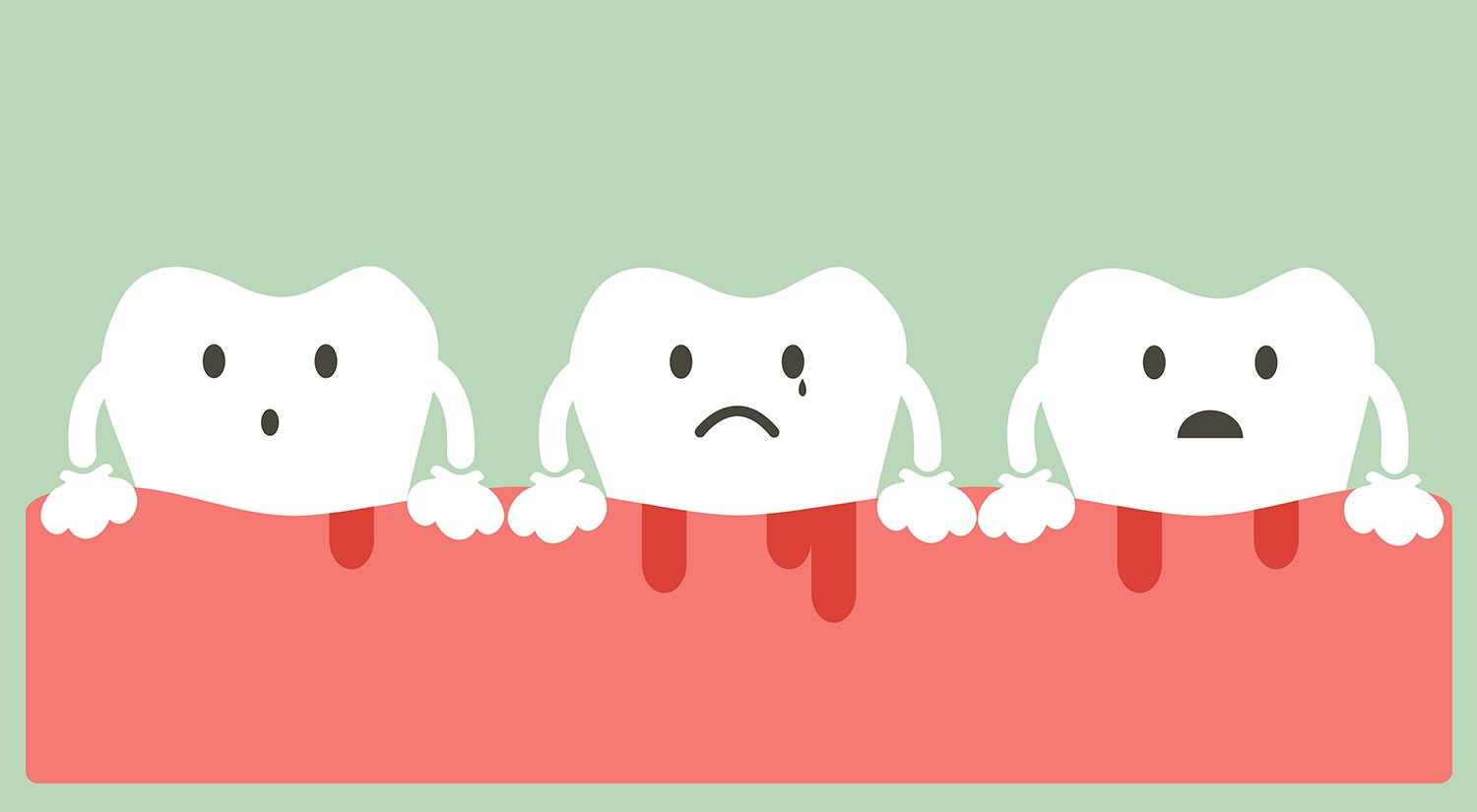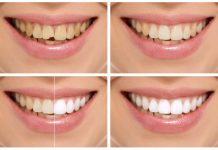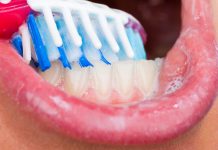From a simple case of bleeding gums to painful gum recession, gum disease is a problem that you need to deal with as soon as possible.
Here, we’ll discuss the hierarchy of gum disease and what happens at each stage. You’ll also learn what you can do at home in your daily routine to prevent this from happening and protect your dental health.
If all else fails, fear not. Your dentist can help you with a treatment plan to manage gum disease at any stage of gum disease (officially dubbed “periodontitis”).
Gum Disease Signs and Symptoms
There are a few very common signs of periodontal disease to look for in your daily routine. These signs of gum disease may be signals that your gum health isn’t where it needs to be.
- Red, swollen gums
- Receding gums
- Bleeding on brushing or flossing
- Visible pus
- Teeth feel loose and moveable
- A change in your bite
- Heightened sensitivity to hot or cold foods
- Pain when chewing
- A bad taste in your mouth
- Persistent bad breath
A note of caution: Even if you do not have any of these symptoms, it is possible you still have gum disease.
Always go to your routine dental visits for check-ups—gum disease diagnosis is one reason you should stick to these appointments.
How Your Dentist Will Diagnose Gum Disease
When you show up for a dental appointment, you may not realize your dentist and hygienist are looking for gum disease symptoms. Here are some of what happens at your dental cleanings that can help recognize periodontitis.
1. Medical History
You may be thinking, “Did I come to the doctor’s office, or the dentist’s?” This is a common notion many people have when a dentist asks about certain diseases that run in their family, or if they’ve recently been diagnosed with any systemic conditions.
One reason for this is that any medication you may have been prescribed by your physician could cause severe consequences for your oral health.
For example, medications that have the side effect of causing a dry mouth, or “xerostomia,” can lead to tooth decay.
The saliva in our mouths helps us wash away food and other debris to rid of plaque. Plaque naturally forms a biofilm on the surface of our teeth after we eat or drink anything with carbohydrates or sugars.
Over time, if plaque is not removed regularly by brushing and flossing, it can lead to tartar buildup. Tartar is also called “calculus,” and it forms a yellow, brown deposit after plaque hardens. Unlike plaque, you cannot safely remove tartar on your own. This can only be done professionally by a dentist or dental hygienist.
2. Pocket Depth Measurement
This part of your dental exam and teeth cleaning is called “perio probing.” Here, dentists use an instrument called a periodontal probe with markings in millimeters used to measure the pocket depths around each and every tooth.
With firm and gentle pressure, the perio probe is inserted into your gingival sulcus, which is the space between your tooth and the gum surrounding it.
Healthy measurements are between 1-3mm of pocket depth.
Generally, anything deeper than that indicates gum inflammation that is making the pocket deeper. The deeper the pocket, the looser the gums surrounding your tooth, and the higher the degree of inflammation.
Another sign that your dentist or dental hygienist will look for when measuring pocket depth is bleeding upon probing. We may be poking at you, but a periodontal probe is blunted at the end, so it shouldn’t cause any bleeding in a healthy mouth. Bleeding upon probing is not considered normal and is one of the significant signs of gum inflammation.
It is really important that you don’t miss your regular check-ups and cleanings, or reschedule as soon as you can if something pops up. That way, anything out of the ordinary will be caught on early and promptly treated.
3. Dental X-Rays
The purpose of taking an x-ray (radiograph) is help your dentist examine everything in your mouth that is not visible to the naked eye.
The most commonly taken x-rays to evaluate gum disease are “bitewings.” There are four bitewings that are taken, one for each quadrant. Your dentist will be able to see everything from the top of your tooth to its roots, as well as the height of the bone around it.
The periodontal ligament, or PDL, serves as the supporting structure between the tooth and the bone. Bacteria can build up in deep periodontal pockets and cause destruction to the PDL, leading to bone loss and eventual tooth loss.
Taking bitewing x-rays will help your dentist assess if there are any changes to your jawbone as a result of gum disease.
Radiographs are not “one size fits all.” Your dentist will determine your oral profile risk and the frequency of x-rays needed. It may be as recent as every 6 months or only every couple of years.
The Stages of Gum Disease
There are four stages of gum disease, although the lines between these are a bit blurred.
Stage I: Gingivitis
This first stage of gum disease refers to inflammation of the gums.
Bacteria and plaque build up gradually over time along your gingival sulcus. Toxins released from this bacteria may cause deeper periodontal pockets due to damage of the PDL fibers that support the teeth and gums.
As mentioned previously, healthy gums have a probing depth of 1-3 mm. At the gingivitis stage, probing depths will be about 2-4 mm. (1)
You may also have other gingivitis symptoms, like:
- Redness and swelling of the gums
- Bleeding upon flossing
- Bad breath
This is the mildest form of gum disease and therefore does not result in any bone loss or connective tissue loss. The good news is this stage is completely reversible and you can usually correct it at home! We’ll learn more about that later.
Stage II – III: Slight to Moderate Periodontal Disease
These two stages are grouped together because their effects are similar but gradual in strength.
The infection has now penetrated deep into your gums rather than along your gums. You will have:
- Increased redness in your gums
- More bleeding upon brushing
- Worsening bad breath.
For slight periodontal disease, your dentist will observe 4-5 mm in probing depth. As for moderate periodontal disease, we will see probing depths at about 6-7 mm.
The deeper the infection gets into the gums, the greater the destruction of the PDL fibers, and the higher the probing depth.
At this point, the bacteria gets so entrenched into your gums that it actually begins to enter your bloodstream. This can compromise your immune system and might lead to or heighten your risk of other diseases (thanks, mouth-body connection!).
The main distinction from these stages in contrast to gingivitis is the start of bone loss. Bone loss here can range from 20-50%.
At this point, you cannot just cure gum disease at home. Treatment will require a consultation with your dentist.
Stage IV: Advanced Periodontal Disease
As you enter this stage of periodontal disease, bacteria has become more virulent.
You have pocket depths greater than 7 mm and the roots of your teeth may be exposed. Tooth mobility has increased significantly and tooth loss becomes very probable. This changes your overall bite and makes chewing more of a challenge.
Something else your dentist will see are pus-filled abscesses in and around your gums. These abscesses form in because immune system is trying to fight off the infection and keep it from spreading.
Bone loss at this stage is between 50-90%. Due to the severe infiltration of bacteria and the destruction it has caused to the integrity of your teeth, this final stage is only manageable with treatment, not reversible.
Types of Gum Disease
Gum disease happens for a number of reasons, and depending on the cause, it can progress more or less rapidly. The four types of gum disease can help your dentist determine the best course of treatment and help you with expectations for recovery. (2)
- Chronic: Most common of the four types, chronic periodontitis is the gradual progression of inflammation in and around the gums. This typically happens slowly but can worsen rapidly at different points of the condition.
- Aggressive: Typically seen in families, aggressive periodontitis often happens in healthy people and progresses faster than chronic periodontitis. There’s a likely genetic component to this type of gum disease.
- Related to systemic disease: Certain diseases can manifest as gum disease. Periodontitis as a manifestation of systemic disease occurs most often in children with issues like diabetes, respiratory disease, or cardiovascular disease.
- Necrotizing: In necrotizing periodontal disease, lesions cause necrosis (tissue death) of gingival tissue, periodontal ligament, and alveolar bone. People with these kinds of lesions are typically those with compromised immune systems, like patients with HIV, malnutrition, or other immune-compromising conditions.
Options for Gum Disease Treatment at Each Stage
Whether you’re struggling with advanced gum disease or the beginning stages of gingivitis, there are things you can do to keep your gums healthy.
In 1965, Dr. Harald Löe and his colleagues conducted a study called “Experimental Gingivitis in Man.”
Dr. Löe asked eleven healthy male dental students to be experimental subjects. The participants had their teeth cleaned and scaled to provide a baseline of their gingival health. They were then asked to cease alloral hygiene measures. That means no brushing, flossing, or mouth rinsing.
I imagine this might have been hard for their girlfriends. But, I digress.
As oral hygiene measures were withdrawn, plaque accumulated and the subjects developed gingivitis in a range of 9-21 days. They were then asked to begin oral hygiene measures again.
Although some men took a longer time to develop gingivitis, all the men returned to their normal, healthy status in about 7-11 days. They did this on their own, with no professional help, but only consistent oral care and hygiene. (3) Clearly, there’s something important in that daily routine!
Let’s look at the treatment options for each stage of gum disease.
1. Treatment for Gingivitis
The purpose of Dr. Harald Löe’s experiment (though this type of research is considered unethical in today’s research guidelines) was to prove that the mildest form of gum disease, gingivitis, is completely reversible.
Your dentist or hygienist will give you a dental prophylaxis, or “prophy.” This is what is known as a professional cleaning. (4) It will consist of supragingival (above the gum line) and subgingival (below the gum line) removal of plaque, calculus, and staining.
However, your provider can only do so much. The only way of reversing gingivitis at this stage is good oral hygiene on your part. Brushing twice a day for two minutes at a time, flossing at least once, and regular dental check-ups will get you back to a healthy smile.
2. Treatment for Slight to Moderate Periodontal Disease
At this stage, the infection has gotten deep enough into your tissues that a prophy, brushing, or flossing just won’t cut it. Here, your dentist will introduce a non-surgical procedure called scaling and root planing procedure (SRP for short).
“Scaling” is when your provider cleans out the toxins in your periodontal pockets. “Root planing” is when he or she smooths out the surfaces of your roots to help your gums reattach. (5) Generally, this procedure causes very little discomfort. If you have sensitive teeth, your dentist may numb your gums with a local anesthetic.
An SRP can be done in a single visit, but it is usually broken up into appointments per quadrant (¼ of the mouth) or by halves, depending on the severity. After an SRP, your gums may feel tender and sensitive.
If you are consistent with a proper oral hygiene regimen after the procedure, your gums should turn back to their smooth texture and natural pink color within a few weeks.
Other ways to handle this stage of gum disease at home include a gum disease diet, using knotted floss to dislodge stubborn food particles, and trying mouth tape to cut down on mouth breathing at night.
3. Treatment for Advanced Periodontal Disease
Flap Surgery
At this stage, your bone and surrounding supporting tissue have been significantly destroyed. The objective of flap surgery is to reduce the depth of the periodontal pockets and regenerate the PDL fibers.
After numbing the area with local anesthetic, your dentist will make a flap-like incision around the gum tissue. The gums are lifted back, which allows a thorough cleaning of all the diseased tissue that has infiltrated. The flap is then sealed tightly so the gums fit snugly around the teeth and the healing process takes place.
After the procedure, you will have reduced pockets, which makes it easier to maintain your oral health. A combination of professional maintenance and consistent home care of your teeth will help prevent recurrence of this disease. (6)
Bone Graft
If you have teeth lost to gum disease, the bone around those teeth will also be lost. Since there is no support in that area, your skin will droop and it will give you an older-looking appearance.
Fortunately, bone grafting helps regenerate any bone that was lost to periodontal disease.
Essentially, what your dentist is doing is placing natural or synthetic bone that works with your body to help build new bone. Tissue-stimulating growth factor proteins may also be used to help your body regrow bone.
In cases with exposed tooth roots, your dentist may suggest a soft tissue graft. Recovery following the bone big graft procedure varies with each patient, but the entire healing process can take between 4-6 months.
Pinhole Surgery
This particular surgery hasn’t been around long, but some clinicians claim that pinhole surgery can help gum tissue grow back. (7) This would be revolutionary, and the preliminary results are good. However, this procedure is in its infancy and it’s not yet proven to be a long-term solution.
Causes and Risk Factors of Gum Disease
Depending on your individual genetics, lifestyle, diet, and other factors, you may be at a higher or lower risk of gum disease. Let’s look at what science tells us are the most common risk factors. (8, 9)
Smoking & Tobacco Use
This one is no surprise. Studies have shown that smoking causes an increase in gum recession and in bone loss.
If you are a current smoker, you have four times the chance of developing periodontal disease in relation to non-smokers.
Research also shows that periodontal therapy is less effective in smokers than it is in non-smokers. Be above the influence, friends.
Genetics
There has been research done in twins that suggest “50% of susceptibility to [gum] disease is due to host factors.” This could be because twins share very similar environmental and behavioral exposures.
Stress
Everybody suffers from chronic stress in his or her own way. People with higher levels of stress have a greater incidence of developing periodontal disease.
Stress depresses our immune system and causes an imbalance in our homeostasis. When you are stressed out, you release a higher number of inflammatory cells, which can promote tissue damage.
Another reason stress is associated with poor oral hygiene is sometimes, you have other things preoccupying your mind. You may not be giving your oral hygiene the attention it needs in times of emotional stress.
The key takeaway here is: we all need a good massage or a spa day every once in a while. Grab some friends and try to unwind; your mouth will thank you.
Medication
Some medications decrease your salivary flow, which impacts its ability to wash away plaque and debris. This is important because saliva helps prevent plaque buildup and gum inflammation.
These medications include but are not limited to:
- Antihistamines
- Antihypertensives
- Anticonvulsants
- Sedatives
Ask your physician if any of the medications you’ve been prescribed causes dry mouth, or “xerostomia.” If so, perhaps your dentist and physician can work together to find another alternative.
Orthodontic Treatment
Some types of partial dentures, braces, or other orthodontic devices can make it hard to remove all the tartar and calculus buildup common to gum disease.
Diet
Studies in adolescents aged 11-18 have shown that kids in this age group do not eat many fruits and vegetables, which are sources high in vitamin C. Moreover, calcium-rich beverages such as milk have decreased while sugary beverages such as sport-drinks have increased.
A decrease in calcium and vitamin C have been associated with an increased risk of periodontal disease.
In general, a diet heavy on carbohydrates (breads, pastas, crackers, sugary treats, etc.) is going to be bad for oral health, particularly when you aren’t keeping up with dental hygiene as well. Keep in mind that your mouth and body as a whole need healthful, whole foods to function well.
Age
There is a caveat to this one: the risk of gum disease doesn’t just go up because a person merely gets older; it’s tied in to various other factors.
For example, as we get older, we lose some of our manual dexterity and thus cannot brush as well as we used to. You may become more forgetful and forget to practice as oral hygiene on a daily routine.
People are also living longer! As we’re retaining our teeth for a longer period of time, they need to be maintained for a longer period of time. This can be hard to do since as we age, we naturally develop many other systemic diseases that negatively impact our oral health.
This brings us to the next point.
Periodontitis and Other Diseases
When you think about gum disease, you shouldn’t think only of your oral health. There are connections between gum disease and other health problems, including diabetes, heart disease, Alzheimer’s, pneumonia, and even cancer.
Diabetes
Poor glycemic control has been associated with higher rates of periodontal disease. (10) The good news is that patients with controlled diabetes respond favorably to periodontal treatment. Check your HbA1c count regularly to make sure your blood sugar is in the target range.
You may also want to consider natural diabetes treatment options, like dietary alteration. These have a great track record of effectively managing blood sugar and A1c levels.
Heart Disease
There has been a lot of research done on the association between cardiovascular disease and periodontitis. High cholesterol and atherosclerotic plaque together may increase the risk for chronic periodontitis. (11)
We have many different inflammatory markers in our bodies that serve a variety of functions. Generally, they are increased when there is injury somewhere in your body and your immune system is trying to defend you.
Both periodontitis and heart disease are associated with the same increase in inflammatory markers, C-reactive protein (CRP) and Interleukin-6 (IL-6). (12)
The only confirmed causal link between oral disease and systemic infection is that of infective endocarditis, an inflammation in the lining of the heart. (13)
Bacteria are more likely to escape into the bloodstream when the biological width, the seal of gums to teeth that serves to protect the alveolar bone, isn’t healthy, like in gum disease. These bacteria can then collect on the heart to cause endocarditis—which is most likely after a root scaling and planing.
Alzheimer’s Disease
There are two mechanisms by which association Alzheimer’s and gum disease are explained.
One theory is that the bacteria in gum disease that seeps into your bloodstream increases inflammatory markers, which leads to systemic inflammation. These markers are capable of crossing into the brain and leading to neuronal damage.
The second mechanism is explained by the bacteria from your plaque crossing into the brain. Dental plaque enters the brain via the bloodstream or peripheral nerves. This organisms then cause and inflammatory response in your central nervous system (CNS), which leads to cognitive impairment. (14)
A team of researchers released a compelling study in 2019 introducing a possible causation between gum disease and Alzheimer’s. (15) While this hasn’t been confirmed by other studies or human trials, it’s enough to consider being more diligent treating gum disease.
Hematologic Disorders (Leukemia)
Gingival hyperplasia, which is overgrowth of gum tissue around the teeth, can be an early symptom of acute leukemia. (16)
Chemotherapy or bone marrow transplantation can also negatively affect gingival health. Some of the symptoms are abscesses, inflamed gums, or severe redness.
Pneumonia
The same people at risk for pneumonia are typically those at risk for gum disease. Although it’s not clear if one causes or contributes to the other, they are closely connected.
One proposed reason for this connection is that patients in hospitals and nursing homes that frequently contract pneumonia also can’t keep up with good oral care. This may upset the oral microbiome and set the stage for other immune system-compromising infection. (13)
How to Prevent Gum Disease
There are several things you can do regularly if you notice warning signs of gum disease—or to prevent these from ever happening.
Brush twice a day for 2 minutes. Use your smartphone or a brush timer as a measurement of time to how long you’ve been brushing.
Floss at least once a day to remove plaque from places your toothbrush can’t get access to.You know when your mom tells you to clean your room, and you think it’s clean, but then she goes in and finds areas that aren’t really clean? It’s basically the same concept, but with flossing.
Avoid smoking (anything) and all forms of tobacco. This includes cigarettes, cigars, “dip” or chewing tobacco, and hookah. Being healthy is the new cool.
Maintain a healthy diet. Now, I’m not telling you to go vegan, but I am telling you that it’s important to add fruits and vegetables to get your daily dose of vitamin C and calcium.
Ask your physician if any of your medications cause dry mouth, or “xerostomia.” If they do, ask if there are any other alternatives available. It’s important for different healthcare providers to be in contact so we can provide you with the best possible care.
Tape your mouth shut at night. Weird habit, but great results. Mouth taping cuts down on mouth breathing while you sleep. This, in turn, can help resolve dry mouth.
Don’t use conventional mouthwash. I know what you’re thinking. This is the stuff that’s supposed to give me a cleaner mouth and me have kissable breath! But it’s just not good for your oral health.
So many mouthwashes have a high alcohol content, which dries your mouth and disrupts your oral microbiome. Dry mouth and an imbalance of bacteria are both risks for plaque retention. You can read more about other DIY mouthwash alternatives here.
Try natural methods of gum disease prevention. These may include using turmeric in a lot of your recipes, oil pulling, and taking oral probiotics to support a healthy oral microbiome.
Always, always schedule regular check-ups and professional cleanings. You will have a much less chance of developing anything suspicious if your dentist is monitoring your health. Remember, preventative is always better than constructive!
Source: AskTheDentist







